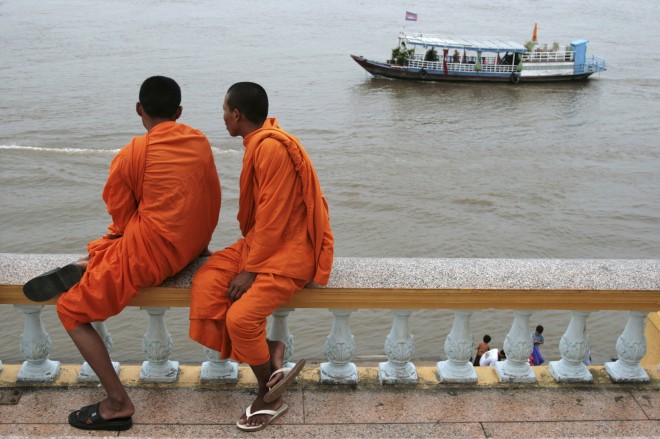Ageing ceramics at the National Museum
“Do you think it’ll just be full of old pottery?” my friend asked as we set off for the National Museum, our first stop in the Cambodian capital. Now I won’t lie to those averse to aged ceramics, there is pottery. But there is also a sublime collection of Khmer sculptures and art, which, had the Khmer Rouge had their way, would not have survived to this day. It’s one of the most absorbing national museums I’ve visited, just large enough to be comprehensive yet compact enough to see it all in a couple of hours, and bizarrely, a simple map illustrating the former domination of the Khmer Empire draws the largest crowds, united in astonishment upon realising just how far and wide it once ruled. Tours Indochina Cambodia
The surprise factor on Sisowath Quay
Phnom Penh is all about this surprise factor. On a walk along Sisowath Quay, the city’s pedestrianised riverfront, you’re likely to witness an aerobics class, local boys skateboarding or the serene sight of monks strolling, clad in orange robes. At the weekend, you’ll probably end up at the Phsar Reatrey night market where chocolate waffles, cold beer, kebabs and fried insects are all abundantly available.
More traditional sights are on the menu too, though, as colourful wats and pagodas (temples) are scattered around the city, and for those who have visited Bangkok’s Grand Palace, the architecture of Phnom Penh’s Royal Palace and glittering Silver Pagoda will ring a bell. Its murals, wats and gardens, and Baccarat crystal Buddha, are reminiscent of those found in the Thai capital. Cambodia travel packages

The sobering Genocide Museum
The colour and pomp of the Royal Palace is in stark contrast to another much-visited spot – the S21 Tuol Sleng Genocide Museum. It’s one of the more sobering things to do in Phnom Penh, but essential for anyone who wants to understand what happened between 1975 and 1979 when Pol Pot’s Khmer Rouge created an atmosphere of suspicion and terror. This former high school was one of about 150 security prisons from those dark days, now home to harrowing exhibits, information panels, a video room and prisoner photographs. The history lesson continues half an hour outside Phnom Penh at Choeung Ek (better known as the Killing Fields) where an audio tour does a fine job of sensitively guiding you through these now-tranquil woods and fields, where over 20,000 mass graves lie, and to the Buddhist stupa (spherical mound-like structure) containing some 8,985 human skulls. It’s not easy listening, but it is done very well.
Cruise the Mekong
Located at the point where the Mekong and Tonle Sap rivers meet, Phnom Penh is a great place to take a leisurely cruise along these famous waterways. Take a boat from Sisowath Quay to view the Royal Palace and National Museum from the water, or spend a couple of hours marvelling at the floating villages and this unique way of life. Tours will set you back about £6-9 an hour. Eat Kampot pepper crab
Originating in the small riverside town of Kampot in the south-east province of Cambodia, this seafood delicacy has become somewhat of a national dish and you'll find excellent versions in the country's capital. A whole fried or baked crab, smothered in a sweet yet spicy peppercorn sauce, it's enough to tempt even the most budget-conscious backpacker away from street food; which is also superb in Phnom Penh, deep-fried tarantula being another delicacy must-try.
Sip a mojito at the Foreign Correspondents' Club
Fancy stepping back in time to colonial Cambodia? Sip on one of the signature cocktails offered at the Foreign Correspondents' Club, a hub for intrepid explorers, aid workers and international journalists throughout the city's colourful and chequered past. Sit and watch the sunset on the banks of the Tonle Sap River and swap tales with locals and toursits alike about the days gone by.